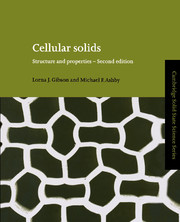Book contents
- Frontmatter
- Contents
- Preface to the second edition
- Preface to the first edition
- Units and conversion tables
- Chapter 1 Introduction
- Chapter 2 The structure of cellular solids
- Chapter 3 Material properties
- Chapter 4 The mechanics of honeycombs
- Chapter 5 The mechanics of foams: basic results
- Chapter 6 The mechanics of foams: refinements
- Chapter 7 Thermal, electrical and acoustic properties of foams
- Chapter 8 Energy absorption in cellular materials
- Chapter 9 The design of sandwich panels with foam cores
- Chapter 10 Wood
- Chapter 11 Cancellous bone
- Chapter 12 Cork
- Chapter 13 Sources, suppliers and property data
- Appendix: The linear-elasticity of anisotropic cellular solids
- Index
- References
Chapter 12 - Cork
Published online by Cambridge University Press: 05 August 2014
- Frontmatter
- Contents
- Preface to the second edition
- Preface to the first edition
- Units and conversion tables
- Chapter 1 Introduction
- Chapter 2 The structure of cellular solids
- Chapter 3 Material properties
- Chapter 4 The mechanics of honeycombs
- Chapter 5 The mechanics of foams: basic results
- Chapter 6 The mechanics of foams: refinements
- Chapter 7 Thermal, electrical and acoustic properties of foams
- Chapter 8 Energy absorption in cellular materials
- Chapter 9 The design of sandwich panels with foam cores
- Chapter 10 Wood
- Chapter 11 Cancellous bone
- Chapter 12 Cork
- Chapter 13 Sources, suppliers and property data
- Appendix: The linear-elasticity of anisotropic cellular solids
- Index
- References
Summary
Introduction and synopsis
Cork has a remarkable combination of properties. It is a light yet resilient; it is an outstanding insulator for heat and sound; it has a high coefficient of friction; and it is impervious to liquids, chemically stable and fire-resistant. Such is the demand that production now exceeds half a million tonnes a year (and 1 tonne of cork has the volume of 56 tonnes of steel).
In pre-Christian times cork was used (as we still use it today) for fishing floats and soles of shoes. When Rome was besieged by the Gauls in 400 BC, messengers crossing the Tiber clung to cork for buoyancy (Plutarch, AD 100). And ever since man has cared about wine, he has cared about cork to keep it sealed in flasks and bottles. ‘Corticum abstrictum pice demovebit amphorae’ sang Horace (27 BC) to celebrate his miraculous escape from death from a falling tree. But it was in the Benedictine Abbey at Hautvilliers where, in the seventeenth century, the technology of stopping wine bottles with clean, unsealed cork was perfected. Its elasticity and chemical stability mean that it seals the bottle without contaminating the wine, even when it must mature for many years. No better material is known, even today.
Commercial cork is the bark of an oak (Quercus suber) that grows in Portugal, Spain, Algeria and California.
- Type
- Chapter
- Information
- Cellular SolidsStructure and Properties, pp. 453 - 467Publisher: Cambridge University PressPrint publication year: 1997
References
- 2
- Cited by



